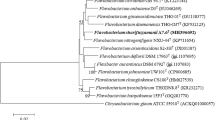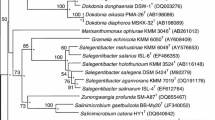Abstract
A bacterial strain designated RZ03T was isolated from an intertidal sand sample from the Yellow Sea in China and characterised using a polyphasic taxonomic approach. Cells of strain RZ03T were observed to be Gram-stain negative, aerobic, and oxidase and catalase positive rods showing gliding motility and forming yellow colonies. Growth was found to occur at 7–30 °C (optimum, 25 °C), at pH 5.5–9.5 (optimum, pH 6.5–7.0) and with 0.5–5% NaCl (optimum, 1.5–2%). Phylogenetic analysis based on 16S rRNA gene sequences indicates that strain RZ03T clusters within members of the genus Flavivirga of the family Flavobacteriaceae and is closely related to the type strains Flavivirga amylovorans JCM 17112T and Flavivirga jejuensis JCM 17113T (97.9% and 97.5% similarity, respectively). The predominant cellular fatty acids are iso-C15:0, iso-C15:1 G, iso-C17:0 3-OH and iso-C15:0 3-OH and the major respiratory quinone is MK-6. Polar lipids include phosphatidylethanolamine, three unidentified aminolipids, an unidentified phospholipid and four unidentified lipids. The genome of strain RZ03T is 4.88 Mbp with a G+C content of 32.2 mol%. A total of 4152 genes are predicted, with 4052 protein-coding genes, 51 RNA genes and 49 pseudogenes. This polyphasic study suggests that strain RZ03T represents a novel species in the genus Flavivirga, for which the name Flavivirga rizhaonensis is proposed. The type strain is RZ03T(= KCTC 62833T = MCCC 1K03615T).


Similar content being viewed by others
References
Bernardet JF, Nakagawa Y, Holmes B, Subcommittee on the taxonomy of F & Cytophaga-like bacteria of the International Committee on Systematics of P (2002) Proposed minimal standards for describing new taxa of the family Flavobacteriaceae and emended description of the family. Int J Syst Evol Microbiol 52:1049–1070
Blenden DC, Goldberg HS (1965) Silver impregnation stain for leptospira and Flagella. J Bacteriol 89:899–900
Chun J, Oren A, Ventosa A et al (2018) Proposed minimal standards for the use of genome data for the taxonomy of prokaryotes. Int J Syst Evol Microbiol 68:461–466
Couvin D, Bernheim A, Toffano-Nioche C, Touchon M, Michalik J, Neron B, Rocha EPC, Vergnaud G, Gautheret D, Pourcel C (2018) CRISPRCasFinder, an update of CRISRFinder, includes a portable version, enhanced performance and integrates search for Cas proteins. Nucleic Acids Res 46:W246–W251
Edgar RC (2004) MUSCLE: a multiple sequence alignment method with reduced time and space complexity. BMC Bioinform 5:113
Felsenstein J (1981) Evolutionary trees from DNA sequences: a maximum likelihood approach. J Mol Evol 17:368–376
Felsenstein J (1985) Confidence limits on phylogenies: an approach using the bootstrap. Evolution 39:783–791
Fitch WM (1971) Toward defining the course of evolution: minimum change for a specific tree topology. Syst Zool 20:406–416
Gosink JJ, Woese CR, Staley JT (1998) Polaribacter gen. nov., with three new species, P. irgensii sp. nov., P. franzmannii sp. nov. and P. filamentus sp. nov., gas vacuolate polar marine bacteria of the Cytophaga-Flavobacterium-Bacteroides group and reclassification of ‘Flectobacillus glomeratus’ as Polaribacter glomeratus comb. nov. Int J Syst Bacteriol 48(1):223–235
Guindon S, Dufayard JF, Lefort V, Anisimova M, Hordijk W, Gascuel O (2010) New algorithms and methods to estimate maximum-likelihood phylogenies: assessing the performance of PhyML 3.0. Syst Biol 59:307–321
Kimura M (1983) The neutral theory of molecular evolution. Cambridge University Press, Cambridge
Komagata K, Suzuki KI (1987) 4 Lipid and cell-wall analysis in bacterial systematics. Methods Microbiol 19:161–207
Kumar S, Stecher G, Li M, Knyaz C, Tamura K (2018) MEGA X: molecular evolutionary genetics analysis across computing platforms. Mol Biol Evol 35:1547–1549
Langille MG, Brinkman FS (2009) IslandViewer: an integrated interface for computational identification and visualization of genomic islands. Bioinformatics 25:664–665
Lee JH, Kang JW, Choe HN, Seong CN (2017) Flavivirga eckloniae sp. nov. and Flavivirga aquimarina sp. nov., isolated from seaweed Ecklonia cava. Int J Syst Evol Microbiol 67:3089–3094
Lefort V, Longueville JE, Gascuel O (2017) SMS: smart model selection in PhyML. Mol Biol Evol 34:2422–2424
Liu A, Zhang XY, Chen CX et al (2013) Neptunomonas qingdaonensis sp. nov., isolated from intertidal sand. Int J Syst Evol Microbiol 63:1673–1677
Loenen WA, Dryden DT, Raleigh EA, Wilson GG, Murray NE (2014) Highlights of the DNA cutters: a short history of the restriction enzymes. Nucleic Acids Res 42:3–19
Luo C, Rodriguez RL, Konstantinidis KT (2014) MyTaxa: an advanced taxonomic classifier for genomic and metagenomic sequences. Nucleic Acids Res 42:e73
Marmur J (1961) A procedure for the isolation of deoxyribonucleic acid from microorganisms. J Mol Biol 3:208,IN201
Marraffini LA (2015) CRISPR-Cas immunity in prokaryotes. Nature 526:55–61
Meier-Kolthoff JP, Auch AF, Klenk HP, Goker M (2013) Genome sequence-based species delimitation with confidence intervals and improved distance functions. BMC Bioinform 14:60
Moose A (2017) POCP calculation for two genomes. figshare. Software
Na SI, Kim YO, Yoon SH, Ha SM, Baek I, Chun J (2018) UBCG: up-to-date bacterial core gene set and pipeline for phylogenomic tree reconstruction. J Microbiol 56:280–285
Nei M, Kumar S (2000) Molecular evolution and phylogenetics. Oxford University Press, New York
Qin QL, Xie BB, Zhang XY, Chen XL, Zhou BC, Zhou J, Oren A, Zhang YZ (2014) A proposed genus boundary for the prokaryotes based on genomic insights. J Bacteriol 196:2210–2215
Saitou N, Nei M (1987) The neighbor-joining method: a new method for reconstructing phylogenetic trees. Mol Biol Evol 4:406–425
Shmakov S, Smargon A, Scott D et al (2017) Diversity and evolution of class 2 CRISPR-Cas systems. Nat Rev Microbiol 15:169–182
Smibert RM, Krieg NR (1994) Phenotypic characterization. In: Gerhardt P, Murray RGE, Wood WA, Krige (eds) Methods for general and molecular bacteriology. American Society for Microbiology, Washington, pp 607–654
Tatusova T, DiCuccio M, Badretdin A, Chetvernin V, Nawrocki EP, Zaslavsky L, Lomsadze A, Pruitt KD, Borodovsky M, Ostell J (2016) NCBI prokaryotic genome annotation pipeline. Nucleic Acids Res 44:6614–6624
Williams RJ (2003) Restriction endonucleases: classification, properties, and applications. Mol Biotechnol 23:225–243
Wirth JS, Whitman WB (2018) Phylogenomic analyses of a clade within the roseobacter group suggest taxonomic reassignments of species of the genera Aestuariivita, Citreicella, Loktanella, Nautella, Pelagibaca, Ruegeria, Thalassobius, Thiobacimonas and Tropicibacter, and the proposal of six novel genera. Int J Syst Evol Microbiol 68:2393–2411
Wu YH, Xu L, Zhou P, Wang CS, Oren A, Xu XW (2015) Brevirhabdus pacifica gen. nov., sp. nov., isolated from deep-sea sediment in a hydrothermal vent field. Int J Syst Evol Microbiol 65:3645–3651
Yi H, Cho JC, Chun J (2012) Flavivirga jejuensis gen. nov., sp. nov., and Flavivirga amylovorans sp. nov., new members of the family Flavobacteriaceae isolated from seawater, and emended descriptions of the genera Psychroserpens and Lacinutrix. Int J Syst Evol Microbiol 62:1061–1068
Yoon SH, Ha SM, Kwon S, Lim J, Kim Y, Seo H, Chun J (2017) Introducing EzBioCloud: a taxonomically united database of 16S rRNA gene sequences and whole-genome assemblies. Int J Syst Evol Microbiol 67:1613–1617
Zerbino DR, Birney E (2008) Velvet: algorithms for de novo short read assembly using de Bruijn graphs. Genome Res 18:821–829
Zhang XY, Liu A, Liu C, Li H, Li GW, Xu Z, Chen XL, Zhou BC, Zhang YZ (2013) Arenitalea lutea gen. nov., sp. nov., a marine bacterium of the family Flavobacteriaceae isolated from intertidal sand. Int J Syst Evol Microbiol 63:2853–2858
Acknowledgements
This study was supported by grants from the National Natural Science Foundation of China (Grant 81801982) and the Supporting Fund for Teachers’ research of Jining medical University (Grant JYFC2018KJ069).
Author information
Authors and Affiliations
Contributions
Author A. Liu performed the taxonomic analysis and wrote the manuscript. Authors H. M. Liu, F. Du, S. Wang, L. Y. Zhao, and H. H. Zhang performed the physiological analysis. Authors Y. Q. Li, Q. J. Xue and X. Z. Li carried out lipid analyses. All authors read and approved the final manuscript.
Corresponding author
Ethics declarations
Conflict of interest
The authors declare that there is no conflict of interest.
Additional information
Publisher's Note
Springer Nature remains neutral with regard to jurisdictional claims in published maps and institutional affiliations.
Electronic supplementary material
Below is the link to the electronic supplementary material.
Rights and permissions
About this article
Cite this article
Liu, A., Liu, HM., Du, F. et al. Flavivirga rizhaonensis sp. nov., a marine bacterium isolated from intertidal sand. Antonie van Leeuwenhoek 112, 1645–1653 (2019). https://doi.org/10.1007/s10482-019-01291-7
Received:
Accepted:
Published:
Issue Date:
DOI: https://doi.org/10.1007/s10482-019-01291-7




